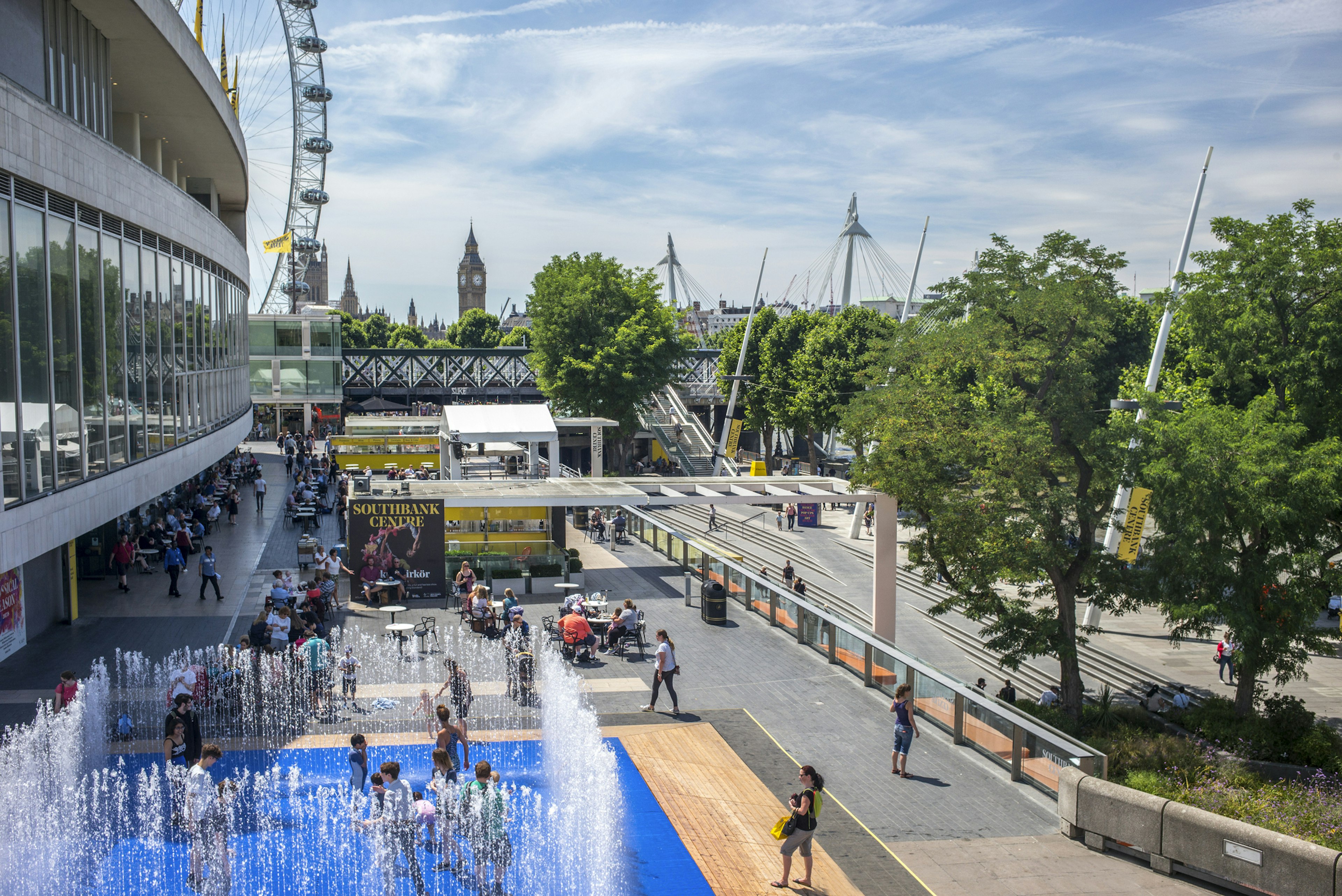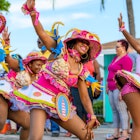
Sep 13, 2021 • 7 min read



Get to know London with this neighborhood guide © Alexander Spatari / Getty Images
Visitors to London may have heard of Oxford Street and Soho, the South Bank and the City, but, as with any sprawling city with a large population, there's way more to it than that.
To help you choose where you want to spend your time, we've got the lowdown on the top neighborhoods in this incredible city.
Whether you're looking for the best area for culture, where to book your accommodation, or where to head for a great family day out, here's what you need to know about London's top neighborhoods.

The West End is a larger region made up of lots of neighborhoods, including Soho, Covent Garden, Chinatown, "Theatreland", Bloomsbury and Westminster. It encompasses many of London’s most iconic locations, buildings and museums, notably Trafalgar Square, Piccadilly Circus, Buckingham Palace, Westminster Abbey and the British Museum.
If your budget allows, staying here ensures you'll have all the must-sees and -dos within walking distance, but you’ll likely pay "through the nose," as Londoners say, for that luxurious convenience, and with the center thronging with visitors it's not exactly relaxing.
The West End is also a center for entertainment, packed with theaters, nightclubs, bars and restaurants, with great spots to while away an evening throughout Soho and Covent Garden.
Shoppers should head to Oxford and Regent Streets for high-street brands, Bond Street for luxury brands, Covent Garden for market stalls and boutiques, and Soho for specialist and independent stores.

The South Bank, the stretch along the riverside between Westminster Bridge and Tower Bridge, is a cultural hub and must-visit area for art lovers, theater-goers and architecture buffs. This popular area is home to performance spaces such as Shakespeare's Globe and the Southbank Centre, as well as gallery giant Tate Modern.
If you're looking for family entertainment, you'll find the London Dungeon, Sea Life London Aquarium and London Eye all grouped together near Westminster Bridge.
There are bars and restaurants throughout the neighborhood, but for a popular foodie experience, choose something from one of the fresh-food stalls at Borough Market or the less-crowded Maltby Street Market, which is in a quieter residential area south of London Bridge.
Once a cheap alternative to the central accommodation options north of the Thames, the South Bank has seen prices rise to match those found across the river. But if you’re an arts-and-culture kind of person, this is the area for you, especially given that it's a short, pleasant walk across one of the many stunning bridges to enter the City proper.

For its small size, the City of London – also known as the Square Mile – punches well above its weight for must-see attractions. This neighborhood is home to the Tower of London and St Paul’s Cathedral – you could easily spend half a day at each, learning all about the city's often-gruesome history.
For astonishing (and free) views across London, book advance tickets to the Sky Garden, an indoor garden on the 43rd floor of a building known as the Walkie Talkie due to its curved top. In 2026, the Museum of London will reopen as The London Museum, with new innovative galleries and display spaces within Smithfield's Grade-II-listed market buildings.
Very few people actually live in The City, so it's often quite empty in the evenings and on weekends, allowing for people-free exploration of its alleyways and Christopher Wren–designed churches. But that also means fewer accommodation options and those that are here tend to be pricey.
This is probably the best-connected neighborhood in the whole of London, however, so what you’re really paying for is convenience and surprisingly quiet streets right in the heart of one of the world’s noisiest cities.

This part of west London has many superb restaurants and a lot of decent accommodation options. It's home to the iconic Portobello Road Market, which sells an eclectic mix of fashion, trinkets, antiques and street food, and the Design Museum, where the history of modern design is covered in a lavish gallery.
The neighborhood is marginally cheaper to stay in than central London, which is only a five-minute Tube ride away. But there's plenty of reason to linger here. There are grand mansions, imposing churches and charming canals, making this a lovely place for a wander. Find vibrant nightlife in Notting Hill and Shepherd’s Bush.

Well-groomed Kensington is among London’s most handsome neighborhoods. It has three fine museums: the V&A offers decorative arts; the Natural History Museum covers everything to do with nature; and the Science Museum takes you on an interactive exploration of materials, space and time.
This is in addition to excellent dining and shopping, lovely parks and grand period architecture. You could easily spend a day at each one of the museums before heading off to explore the superb shopping in Harrods and Harvey Nichols.
Make time, too, for one of London's greatest parks: Hyde Park and the adjoining Kensington Gardens, with tree-lined avenues, rose gardens, a boating lake and graceful parkland.
Like everywhere else near central London, accommodation prices might empty your wallet, but then you can boast that you’ve got the King as a neighbor. Well served by London’s public transport, this is the city’s museum district and therefore a much quieter option than the center of town, which is just a mere 10 minutes on the Underground.

The East End is vast, with no specific boundaries, but is generally accepted to include the neighborhoods of Dalston, Hackney, Whitechapel, Bethnal Green, Stepney, Mile End and Bow.
The groundbreaking Whitechapel Gallery, a favorite of art students, is a major sight in the area and has displayed modern and contemporary works since 1901.
One of the best ways to explore this part of London is to take a bike along Regent’s Canal at the bottom of Broadway Market. You can follow the waterway to the Docklands, or branch east at Victoria Park, following the Hertford Union Canal to Hackney Wick and the Queen Elizabeth Olympic Park.
Visit on a Sunday to appreciate the wonders of Columbia Road Flower Market.
The further east you head, the quieter it gets and the better the rates for accommodation. Out here, the journey time into central London will begin to creep up, but the Tube and Overground links are good, so it’s a worthwhile compromise.

Docklands is made up of the area on the north side of the river from Wapping through to Royal Victoria Docks, including Limehouse and the Isle of Dogs. This is home to the ultramodern tower blocks of Canary Wharf, which contrast with the converted warehouse buildings that date from the early 1800s.
Discover the city's maritime past at the Museum of London Docklands and visit Trinity Buoy Wharf, an arty area where you'll find London's only lighthouse. A cable car offering impressive views over the river and surrounding docklands connects Royal Victoria Dock to the O2 on the Greenwich Peninsula, the other side of the Thames.
Conveniently linked to the heart of London by the Docklands Light Railway (DLR), the Docklands is a quiet neighborhood favored by families wanting to base themselves away from the hustle and bustle of the city center.

Packed with a variety of drinking and dancing venues, including cocktail bars, subterranean nightspots, converted warehouses and clubs, the areas of Shoreditch, Hoxton and Spitalfields in the east are historic city-fringe neighborhoods best known for urban street life and a vibrant nightlife.
Probably offering the best rates for accommodation within earshot of central London, the east’s hipsterville is well connected and convenient, but expect the evenings to be noisy and the streets to be busy.
During the day, explore the neighborhood boutiques, vintage shops, markets and cafes, and stroll Brick Lane, which bears witness to London's long history of migration, as well as being one of the city's best spots to see street art.


The neighborhood of Greenwich (pronounced "gren-itch") offers everything a visitor might want on a day out in London: there's a food market, an antique market, grand architecture, historical sites, plenty of pubs, several museums and a vast park to keep any little people happy. This is all located around a lively center right next to the Thames.
Head up the hill in Greenwich Park to the Royal Observatory, where you can learn about space and time, as well as enjoy the views of Canary Wharf on the other side of the river. There are incredible murals in the Painted Hall at the Old Royal Naval College, a beautiful complex of buildings designed by Christopher Wren. Lovers of British maritime history should spend time browsing the National Maritime Museum and the Cutty Sark clipper ship. Nearby Deptford offers independent shops and craft breweries.As the furthest east of all the neighborhoods and a largely residential spot, Greenwich is definitely one of the quietest, and accommodation should be more reasonably priced, but the paucity of options means that’s often not the case. A convenient river ferry taxi and the Docklands Light Railway ensure Greenwich and Deptford are nevertheless well connected to central London.


Neighborhoods
Birmingham’s best neighborhoods for craft beer and colorful street artJun 7, 2022 • 5 min read

Sep 13, 2021 • 7 min read


Jan 6, 2020 • 4 min read





